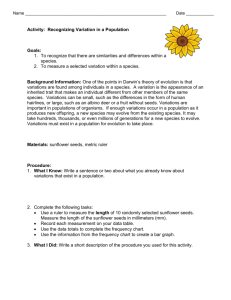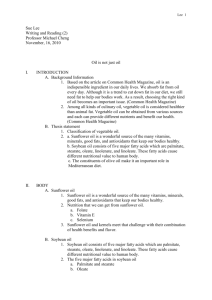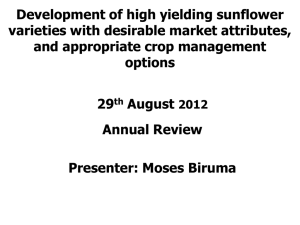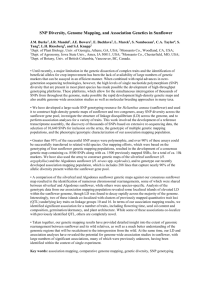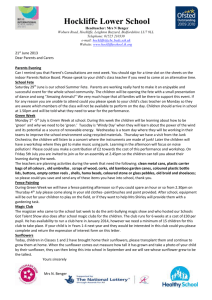“Challenges for the Sunflower Oil Market for 2020”
advertisement
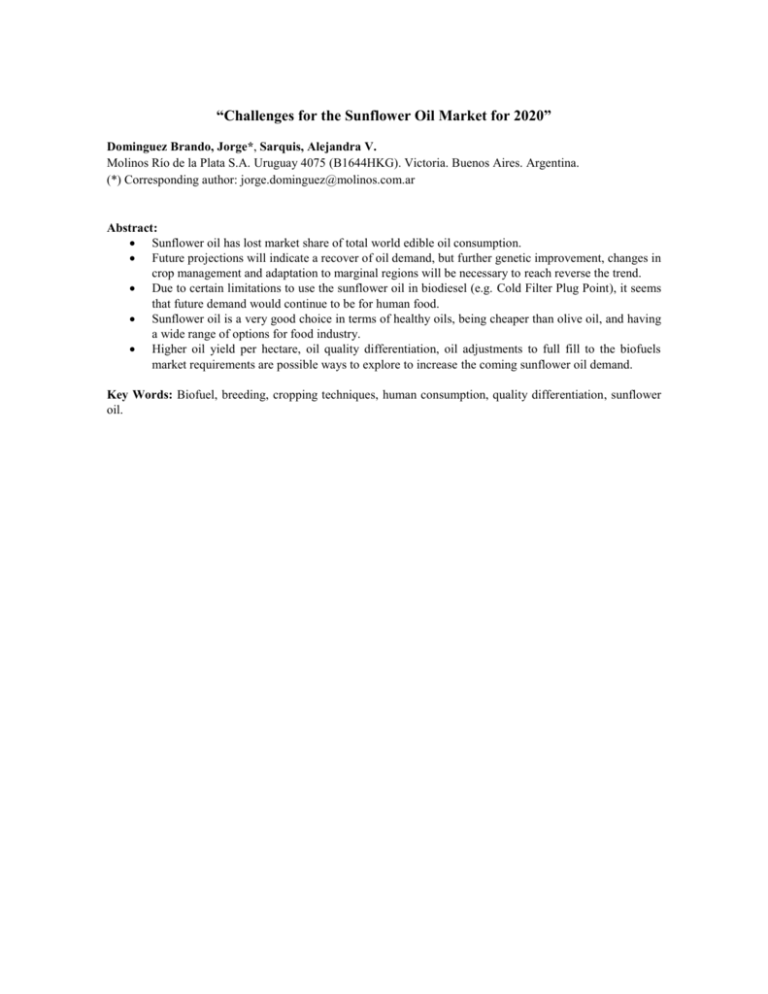
“Challenges for the Sunflower Oil Market for 2020” Dominguez Brando, Jorge*, Sarquis, Alejandra V. Molinos Río de la Plata S.A. Uruguay 4075 (B1644HKG). Victoria. Buenos Aires. Argentina. (*) Corresponding author: jorge.dominguez@molinos.com.ar Abstract: Sunflower oil has lost market share of total world edible oil consumption. Future projections will indicate a recover of oil demand, but further genetic improvement, changes in crop management and adaptation to marginal regions will be necessary to reach reverse the trend. Due to certain limitations to use the sunflower oil in biodiesel (e.g. Cold Filter Plug Point), it seems that future demand would continue to be for human food. Sunflower oil is a very good choice in terms of healthy oils, being cheaper than olive oil, and having a wide range of options for food industry. Higher oil yield per hectare, oil quality differentiation, oil adjustments to full fill to the biofuels market requirements are possible ways to explore to increase the coming sunflower oil demand. Key Words: Biofuel, breeding, cropping techniques, human consumption, quality differentiation, sunflower oil. Introduction: Sunflower is one of the most important oilseed crops in the world. Global production grew steadily in last 25 years (PS&D - USDA, 2011), and FAO expect a total world output close to 60 million tones towards 2050 (Figure 1). The four largest producers (Russia, Ukraine, European Union and Argentina) account for 70% of global volume, with an exponential growth of production in the last ten years in the Black Sea region, with increased acreage an higher yields achieved by the replacing old varieties by hybrid seeds. 70.0 Production (Th Tons) 60.0 50.0 40.0 30.0 20.0 10.0 0.0 1990/99 2000/09 2010/19 2030 (*) 2050 (*) Figure 1: World sunflower production – Projection to 2050. Sunflower seeds are crushed mostly locally and seed world trade represents less than 10 % of global production. World sunflower oil trade accounts for 30 % of total consumption. The European Union is the major destination of the Ukrainian and Argentine exports. Even though, sunflower oil production has increased in last decades, its market share of total 17 Fats & Oils production declined significantly (Oil World Annual, 1994, 1998, 2002, 2006, 2010), while palm oil, soybean oil and rapeseed oil production grew at faster rates (Figure 2). Per caput consumption of sunflower oil has increased marginally in last years (from 1.0 kg/year to 1.4 kg/year in last 30 years). Edible oil for human consumption was the major way of usage. 350.0 10.0 Average Population (Th Millions) 250.0 200.0 150.0 100.0 50.0 0.0 1990/99 2000/09 2010/19 Total Oils & Fats 2030 (*) 2050 (*) SFO Figure 2: Oils & fats world output – Projection to 2050. 2.50 8.0 7.0 2.00 6.0 5.0 1.50 4.0 1.00 3.0 2.0 0.50 1.0 0.0 0.00 1990/99 2000/09 2010/19 Population 2030 (*) Average Production (Kg per Cap./Year) Production (Th Tons) 3.00 9.0 300.0 2050 (*) Production Figure 3: World population and sunflower oil per capita production – Projection to 2050. Today, only 10% of the global production is used for industrial purpose. FAO sunflower oil production forecast for 2050 is 22,4 million metric tons, which implies or a significant increase on per caput consumption. Such increase could come through two ways: I)- A sharp increase in per caput edible sunflower oil consumption (from 1,4 to 2,3 kg/year), driven by lower production costs and or incremental quality differential. (Grey bars) II)- Sharp increase of industrial use, particularly bio fuel (human consumptions as edible oil 1,8 kg/year). (White bars) Sunflower Oil (Million Tons) 25.0 20.0 15.0 10.0 5.0 0.0 1990/99 Production 2000/09 2010/19 Consumption (I) 2030 (*) 2050 (*) Consumption (II) Figure 4: Projected sunflower oil production and consumptions. Discussion: Major challenges for the scientist community around the sunflower value chain will certainly compress genetic improvement to increase yields, enlarge ecological adaptation, improve quality and/or trans-fatty acids composition, and adjust quality to industrial usage requirements. Sunflower oil for human consumption There is a global consensus about that the healthiest oils are those rich in monounsaturated fatty acids, such as olive oil; and those rich in long-chain omega-3 fatty acids, such as fish oils. Olive oil is very stable, but is too expensive to be use in several food industrial applications, for this reason was developed the chemical hydrogenation for common vegetable oils, such as soybean oil and rapeseed oil. The hydrogenated oils support high cooking temperatures but, this process not only increases the stability but also the trans-fatty acids production, highly correlated to risk of cardiovascular disease (Damude and Kinney, 2008). For many years, food scientists have been tested other oils; with similarly resistant to oxidation and good solid fat functionality in order to replaced the hydrogenated oils. These objectives were achieved with the development of high oleic mutants in oilseeds. In recent years, a significant portion of edible oils is covered by sunflower oil, with a sharp focus on its healthiest options (Figure 5) - high nutritional quality and desired industrial functionality – such as high oleic sunflower oil. Sunflower oil is rich in vitamin E, it has antioxidant properties, it is beneficial for the eyes and it can help to prevent Parkinson disease. It contains short-chain omega-3. High Palmític High Estearic High Oleic Mid-Oleic Sunflower 0 20 Saturated Figure 5: Fatty acid characteristics in vegetable oils (National Sunflower Association). 40 60 Monounsaturated 80 100 Polyunsaturated Figure 6: Fatty acid characteristics in sunflower hybrids (ASAGIR). Breeding and selection have developed one of the widest ranges of oil hybrids for diverse uses – edible or industrial oils. In the market, there are 5 leading options for sunflower oils with very different characteristics regarding to the oil content and quality (fatty acid composition) (Figure 6). Despite of this wide range of commercial or pre-commercial hybrids, the scientists are working on new research lines, designed to further increase the versatility of this crop in terms of food, nutrition and health and industrial uses: High Oleic + High Stearic, Gamma and/or Delta Tocopherols in High Oleic, High Oleic + High Stearic + Gamma and/or Delta Tocopherols, Lowest saturated fatty acid content + High Oleic, Increase in fat content (60%), etc. (Pozzi and De la Vega, 2009). Thinking in sunflower just for edible oil, it is possible to propose the possibility to incorporate via breeding, precursors of long-chain omega-3 - such as linolenic acid – and its enzymatic complex to generate representative quantities of EPA (eicosapentaenoic acid) and DHA (docosahexaenoic acid) as in fish oil (Cahoon et. al, 2007). Sunflower oil for biofuels With the promising development of biofuels worldwide, diverse vegetable oils have been target for numerous tests to evaluate their global performance for the current standards, mainly EN 14214 (European Standard). The European Union heads the biodiesel production and consumption (F.O. Licht, 2011), with variable and raising values in each country share – intra European Union – averaging almost 9 million tones in the last 3 years (Figure 7). Production (Th Tons) 40000 35000 Others U.S.A EU-27 Thailand Brazil Indonesia Argentina 30000 25000 20000 15000 10000 5000 100% World Biodiesel Feedstocks 45000 90% 80% 70% 60% 50% 40% 30% 20% 10% 0% 0 2005 2007 2008 2009 2010 2011 2012 2013 2014 2015 2020 (*) Figure 7: Biodiesel world output. 2006 Soy Oil 2007 Rape Oil 2008 2009 Palm Oil 2010 2011 Others Figure 8: Biodiesel feedstocks. Unlike soybean oil and rapeseed oil (Figure 8), sunflower oil presents some limitations to use it for biodiesel production. These limiting factors are close related with the fatty acid composition, been highly dependent on weather conditions, environment and agricultural practices – that include hybrids and sowing dates - (PereyraIrujo et. al, 2009). There is a fundamental parameter which determines the biodiesel versatility in the European Union, and is related to the cold point or Cold Filter Plug Point (CFPP), and in this factor the sunflower oil does not show a standard value (Moser, 2008). On the other hand, and in different with soybean oil, sunflower oil has higher waste in refined process, declining competitiveness with other vegetable oils. Also, it requires wintering process, to remove waxes from the oil (this it means a higher industrial cost). Conclusions: To enlarge the sunflower world value chain, intense scientific and agro technological work should be done in next 20 years. Orientation for sunflower breeders should be lighted by the urgent need of improving the crop competiveness versus other soft oils substitutes (rape, canola and corn oil), both on production costs and quality differentials. Improvement of agronomic practices to increase farmer plots actual yields and to adapt to different environments and situations, will be vital to the future growth of the sunflower oil market share of total oil world output and consumption. Potential Breeding Contributions Addition of highly healthy options, with quality in nutritional value and industrial versatility, could increase the human demand for food. To develop of hybrids with a very stable performance regarding to iodine value, cetane number and CFPP, and with lower waxes content in oil, would use certain volume to the biodiesel industry. Development of hybrids highly adaptable to semiarid regions, would improve the crop competitiveness with other oilseeds, expanding the world agricultural limits. To overcome the severe limiting factor for cropping, that is impost by pigeons, in countries like Argentina. Selecting hybrids with an appropriate position of the heads and/or more resistance to shelling. Potential Agricultural Practices Contributions Agricultural practices to curtail the gap between potential plot trial yields and achievable yields in farmers fields: Proper hybrid selection Timing and high quality operational performance from planting to harvest to maximize radiation capture Water and nutrients management Weeds and pests control based on well tested protocols High operational performance standard at harvest Acknowledgements: We thank Federico Ucke, Ariel Buedo, Pablo Piras, Agustín Garay and Omar Mazany for their contributions. References: Cahoon E.B., Shockey J.M., Dietrich C.R., Gidda S.K., Mullen R.T., Dyer J.M. 2007. Engineering oilseeds for sustainable production of industrial and nutritional feedstocks: solving bottlenecks in fatty acid flux. Current Opinion in Plant Biology 10: 236-244. Damude H.G., Kinney A.J. 2008. Enhancing plant seed oils for human nutrition. Plant Physiology, Vol. 147: 962-968. F.O. Licht. 2011. The 2012 world biodiesel balance. F.O. Licht’s World Ethanol and Biofuels Report. Vol. 10, #3. October 7, 2011. Food and Agriculture Organization of the United Nations, Global Perspective Studies Unit. 2006. World Agriculture: towards 2030/2050. Interim Report. Rome, June 2006. Moser, B.R. 2008. Influence of blending canola, palm, soybean and sunflower oil metil esters on fuel properties of biodiesel. Energy & Fuels 22: 4301-4306. National Sunflower Association. 2011. Sunflower oil… A healthy way to eat! http://www.sunflowernsa.com Oil World Annual 2010. Global Analysis. All mayor oilseeds, oils & oilmeals. Supply, demand and price outlook. Oil World Annual 2006. Global Analysis. All mayor oilseeds, oils & oilmeals. Supply, demand and price outlook. Oil World Annual 2002. Global Analysis. All mayor oilseeds, oils & oilmeals. Supply, demand and price outlook. Oil World Annual 1998. Global Analysis. All mayor oilseeds, oils & oilmeals. Supply, demand and price outlook. Oil World Annual 1994. Global Analysis. All mayor oilseeds, oils & oilmeals. Supply, demand and price outlook. Pereyra-Irujo, G.A., Izquierdo, N.G., Covi M., Nolasco S.M., Quiroz F., Aguirrezábal L.A.N. 2009. Variability in sunflower oil quality for biodiesel production: A simulation study. Biomass and Bioenergy 33: 459-468. Pozzi, G. De la Vega, A. 2009. What can we expect from breeding? In: Scientific bases for the future development of sunflower. Booklet # 16. Argentine Sunflower Association. Production, Supply & Distribution On Line – USDA. 2011. Foreign Agricultural Service. http://www.fas.usda.gov/psdonline/psdquery.aspx



